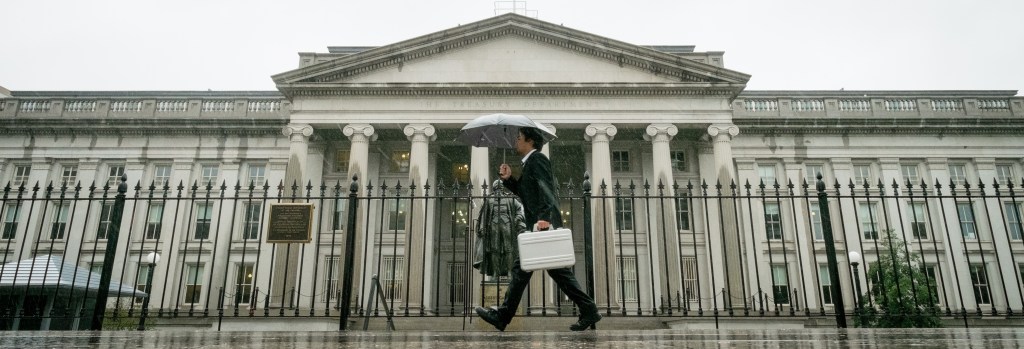WASHINGTON — Suddenly it’s about the deficits. As proposals surface to end the partial government shutdown, raising the nation’s line of credit, and abandoning the drive to upend the 3-year-old health care law, Washington’s attention is turning to spending and the red ink side of the government’s ledger.
Deja vu, as they say, all over again.
Deficits have been at the center of past fiscal confrontations. Taming them has proven to be a difficult task, particularly during a recession and a weak recovery. President Obama and congressional Republicans have tried and either failed or ended up with consequences both sides abhor.
But at the center of a deal to reopen the government and temporarily increase the government borrowing limit is a promise for Republicans and Democrats, including the president, to engage in a new round of negotiations to tackle long-term spending and lower deficits that, while falling now, are on a path to increase the government’s debt to near-record heights over the next two decades.
Here are some basic questions about the government’s fiscal picture.
Q: So, what do the government’s accounting books look like right now?
A: During the just completed fiscal year – Oct. 1, 2012 to Sept. 30, 20113 – the government spent more than it received by somewhere between $650 and $700 billion. Typically deficits are measured as a percentage of the national economy, which would make the recent fiscal year’s deficit about 4 percent of gross domestic product. That’s sizable, but certainly less than the $1 trillion or more deficits early in Obama’s presidency which exceeded 10 percent of the size of the economy. The accumulation of deficits are the national debt, which now stands at $16.7 trillion, about 73 percent of GDP.
Q: Why did it reach such heights?
A: When Obama became president, the country was in a recession. That meant companies and individuals weren’t generating as much tax revenue for the government as before. What’s more, the federal government spent hundreds of billions of dollars to shore up banks during the 2008 financial crisis and Obama ushered through an $800 billion “stimulus” package of spending and tax incentives designed to prime the economy. Deficits had already been increasing under President George W. Bush as Congress enacted two major tax cuts while the nation was fighting wars in Iraq and Afghanistan. The result: the red ink climbed to a whopping $1.4 trillion by September 2009.
Q: So, Obama says deficits have been cut in half while he has been president. Is that true?
A: Yes, but it’s not all his doing. The economic recovery, though modest and fitful, has resulted in businesses and individuals paying more taxes. And the spigot that rushed out spending in 2008-2009 has been turned off. In addition, the interest on the national debt has been kept low thanks to low rates set by the Federal Reserve, and the government-related mortgage companies of Fannie Mae and Freddie Mac have made payments to the federal government that have been greater than expected.
Another factor in the lower deficit is the automatic spending cuts that kicked in during March that reduced domestic and defense spending across the board. Those cuts took effect because Republicans and Democrats could not find common ground on a broader budget deal that would have tackled issues such as tax revenue and spending on big benefit programs like Social Security and Medicare.
The nonpartisan Congressional Budget Office has projected that if those automatic spending cuts remain in place, deficits would drop to 2 percent of the economy in 2015.
Q: That all seems like good news. Is there still a problem?
A: Yes, long term. CBO has said that as interest rates begin to rise, the interest on the national debt will grow. The Baby Boomers have been reaching retirement age and as a growing number of that generation ages, the demands on Social Security and Medicare will grow dramatically. That, together with rising health care costs and federal subsidies for health insurance under Obama’s health care law, will push government expenditures up.
Social Security, Medicare and Medicaid together are the biggest component of the federal budget. The cuts in domestic and defense spending help, but do not represent the growth in the budget. By 2023, government and private forecasters project that deficits will begin to rise annually. By 2038, CBO says the deficit will push the national debt to about 100 percent of the economy – a percentage unseen since just after World War II.
Q: So how can that be, that deficits have been going down, but will climb steadily later.
A: Think of your own budget. Imagine you want to tighten your spending. You eliminate the movies you and your spouse go to every week and cut out that premium channel subscription. You give up buying craft beers and those Friday night restaurant outings. But you have a son and a daughter who will be going to college in three years. That balloon payment on your mortgage will kick in around then. You’ll have to borrow again and spend more, and you won’t have any belt tightening left to do. The federal government is no different as the Baby Boom generation hits Social Security and Medicare age, and as interest rates on the debt rise.
Send questions/comments to the editors.


